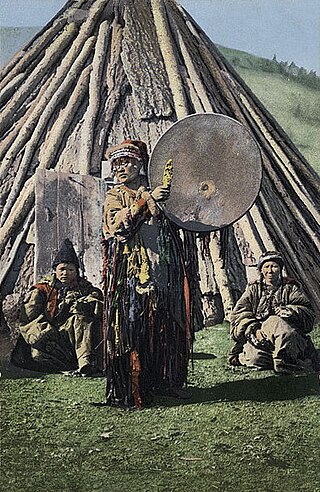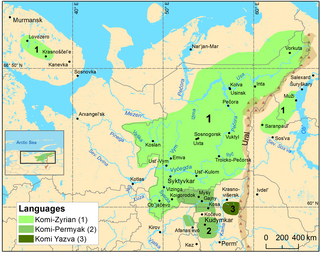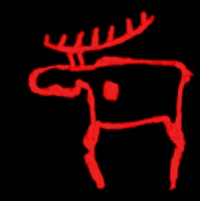This article relies largely or entirely on a single source .(June 2022) |
Komi mythology is the traditional mythology of the Komi peoples of northern Russia.
This article relies largely or entirely on a single source .(June 2022) |
Komi mythology is the traditional mythology of the Komi peoples of northern Russia.
| Mythology |
|---|
A duck egg gave birth to En and Omöl, the spirits of good and evil respectively. En took the form of a swan, Omöl that of a grebe. They rose from the bottom of the primordial ocean to create the world.
In Komi religious belief the human soul (лов, "lov") had a double (орт, "ort", or орд, "ord"). The ort is born with each human being and gives a premonition of death either to the person who is to die or to one of their family.
The land of the dead was usually thought to be far to the north of the living, beyond mountains, rivers and forests. The Komi equivalent of the Styx (the river of the underworld in Greek mythology) was "Syr Yu" (Сыр Ю), "River of Pitch". Dead souls were assigned various means of crossing the river, according to their sins in this world: an iron bridge, a shaky beam, a thin pole or a cobweb. After this the dead had to climb a huge slippery mountain. This was only possible if the person had led a good life and had strong fingernails. Traditionally, the Komis kept their fingernail clippings so they could be buried with them for use in the afterlife.
The Komis had shamans and believed in sorcerers and witches. The most notorious witch in Komi folklore is Yoma (or Yoma-Baba).

Shamanism is a spiritual practice that involves a practitioner (shaman) interacting with the spirit world through altered states of consciousness, such as trance. The goal of this is usually to direct spirits or spiritual energies into the physical world for the purpose of healing, divination, or to aid human beings in some other way.
Finnish mythology commonly refers of the folklore of Finnish paganism, of which a modern revival is practiced by a small percentage of the Finnish people. It has many shared features with Estonian and other Finnic mythologies, but also with neighbouring Baltic, Slavic and, to a lesser extent, Norse mythologies.

Ilmarinen, a blacksmith and inventor in the Kalevala, is a god and archetypal artificer from Finnish mythology. He is immortal and capable of creating practically anything. In addition, he is described as working the known metals of the time, including brass, copper, iron, gold, and silver. The great works of Ilmarinen include the crafting of the dome of the sky and the forging of the Sampo. His usual epithet in the Kalevala is seppä or seppo ("smith"), which is the source of the given name Seppo.
The Komi Republic, sometimes simply referred to as Komi, is a republic of Russia situated in the northeast of European Russia. Its capital is the city of Syktyvkar. The population of the republic at the 2021 census was 737,853, down from 901,189 at the 2010 census.

The Komi are a Permian ethnic group who are indigenous to, and primarily inhabit a region around the basins of the Vychegda, Pechora and Kama rivers in northeastern European Russia. They mostly reside in the Komi Republic, Perm Krai, Murmansk Oblast, Khanty–Mansi Autonomous Okrug, and Nenets Autonomous Okrug in the Russian Federation.

Komi-Permyak language, also known as Permyak, is one of two Permic varieties in the Uralic language family that form a pluricentric language, the other being Komi-Zyryan.

Kets are a Yeniseian-speaking people in Siberia. During the Russian Empire, they were known as Ostyaks, without differentiating them from several other Siberian people. Later, they became known as Yenisei Ostyaks because they lived in the middle and lower basin of the Yenisei River in the Krasnoyarsk Krai district of Russia. The modern Kets lived along the eastern middle stretch of the river before being assimilated politically into Russia between the 17th and 19th centuries. According to the 2010 census, there were 1,220 Kets in Russia. According to the 2021 census, this number had declined to 1,088.

The Nganasans are a Uralic people of the Samoyedic branch native to the Taymyr Peninsula in north Siberia. In the Russian Federation, they are recognized as one of the indigenous peoples of the Russian North. They reside primarily in the settlements of Ust-Avam, Volochanka, and Novaya in the Taymyrsky Dolgano-Nenetsky District of Krasnoyarsk Krai, with smaller populations residing in the towns of Dudinka and Norilsk as well.

Udmurt is a Permic language spoken by the Udmurt people who are native to Udmurtia. As a Uralic language, it is distantly related to languages such as Finnish, Estonian, Mansi, Khanty, and Hungarian. The Udmurt language is co-official with Russian within Udmurtia.

Baltic Finnic paganism, or BalticFinnic polytheism was the indigenous religion of the various of the Baltic Finnic peoples, specifically the Finns, Estonians, Võros, Setos, Karelians, Veps, Izhorians, Votes and Livonians, prior to Christianisation. It was a polytheistic religion, worshipping a number of different deities. The chief deity was the god of thunder and the sky, Ukko; other important deities included Jumala, Ahti, and Tapio. Jumala was a sky god; today, the word "Jumala" refers to a monotheistic God. Ahti was a god of the sea, waters and fish. Tapio was the god of the forest and hunting.

Modern Finnish paganism, also known as Finnish neopaganism or the Finnish native faith, is the contemporary revival of Finnish paganism, the pre-Christian polytheistic ethnic religion of the Finns. A precursor movement was the Ukonusko of the early 20th century. The main problem in the revival of Finnish paganism is the nature of pre-Christian Finnish culture, which relied on oral tradition which may be subject to change over time. The primary sources concerning Finnish native culture are written by latter-era Christians.
Juha Pentikäinen is a professor emeritus of the Department of Religious Studies at the University of Helsinki and a professor of northern ethnography at the University of Lapland and the Institute for Northern Culture in Helsinki. With a field-work oriented approach to the study of religious traditions he is especially interested in the oral history of languages, religions and cultures.
Finnic mythologies are the mythologies of the various Finnic peoples:
Elements of a Proto-Uralic religion can be recovered from reconstructions of the Proto-Uralic language.
Uralic neopaganism encompasses contemporary movements which have been reviving or revitalising the ethnic religions of the various peoples who speak Uralic languages. The movement has taken place since the 1980s and 1990s, after the collapse of the Soviet Union and alongside the ethnonational and cultural reawakening of the Finnic peoples of Russia, the Estonians and the Finns. In fact, Neopagan movements in Finland and Estonia have much older roots, dating from the early 20th century.
The Kört-Aika Monument is a steel statue located at the entrance to the village of Kortkeros, Kortkerossky District, Komi Republic, Russia. It is a statue of a man pulling up several boats with his chains.
Metsavana, also known as metsataat or metsaisa, is the old man of the forest, a forest deity in Estonian mythology.

The Mooseman is an adventure video game developed by the Perm-based Russian studio Morteshka and released in 2017. The game is based on the mythology of Komi, as well as other Finno-Ugric peoples, and is an attempt at artistic reconstruction of mythological plots. The game tells the story of the Mooseman, the shaman and one of the seven sons of the creator god Yen, who must travel to the underworld to retrieve Shondi and save the world from the eternal cold.
"The Tale About Baba-Yaga" is a Russian fairy tale published in a late 18th-century compilation of fairy tales. Variants from oral tradition have been collected in the 19th and 20th centuries from Russian-language and Finno-Ugric speaking tellers. The tale features the witch Baba Yaga as the antagonist of the tale, as she assumes the role of a mother-in-law that viciously hounds her daughter-in-law, the heroine.
The Falcon Pipiristi is a folktale from the Komi people, first published in 1938 in the Russian language. In it, the heroine asks her father to bring an item that belongs to a falcon named Falcon Pipiristi, which she uses to summon him to her bedroom, but her sisters place hooks on the window to hurt him, causing him to fly away. The heroine then goes on a long journey to regain Pipiristi, finding him under the power of a witch, with whom she trades expensive gifts to spend a night in Pipiristi's room. Similar tales have been collected by folklorists from Komi sources.